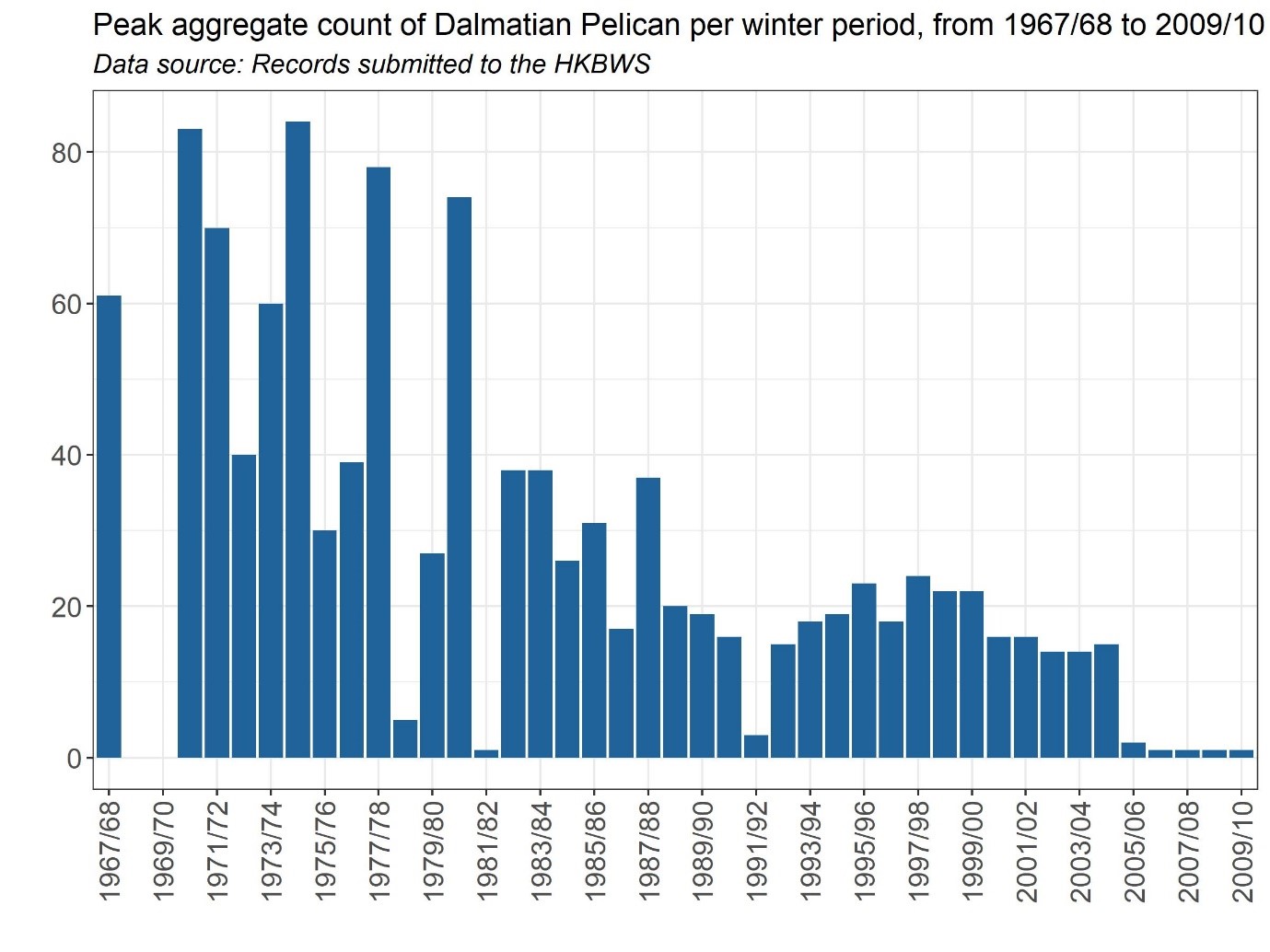Dalmatian Pelican Pelecanus crispus 卷羽鵜鶘
Category I. Previously an uncommon winter visitor, but now probably extinct as a regular wintering species, though accidental birds may occur. Almost exclusively occurred in Deep Bay.
IDENTIFICATION

Jan. 2010, Kinni Ho.
Massive and unmistakeable. Very large bill with dull orange throat sac (paler on first-winter birds). Entirely dull white apart from greyish flight feathers and primary coverts on upperwing, but only diffuse greyish trailing edge and white bases to flight feathers on underwing. Bill becomes brighter and yellow develops on chest as breeding season approaches. First-year plumage is washed pale dull brownish with paler fringes. In flight head held back into upper mantle and tail is short.
VOCALISATIONS
Appears to be silent away from the breeding grounds; no vocalisations reported in HK.
DISTRIBUTION & HABITAT PREFERENCE
All records are from the Deep Bay intertidal area except for 12 seen over Stanley Fort in November 1982 and one near the Soko Islands on 23 April 1988.
OCCURRENCE
Initially, pelicans sighted in HK were thought to be Spot-billed Pelican P. philippensis. Dalmatian Pelican was not identified until 14 March 1971. That for much of the last century the two were generally regarded as conspecific clouded the picture somewhat. However, the last records of Spot-billed Pelican in southern China appear to be those of La Touche (1931-34) and Caldwell and Caldwell (1931), and it is thought now to breed no closer than Cambodia (Elliott et al. 2020b), although it certainly once had a wider range. Furthermore, the pattern of occurrence and number of birds involved during the 1970s was very similar to the period prior, making it almost certain that all pelicans seen in HK were Dalmatian. For the purposes of this work all records of pelicans submitted to the HKBWS, whether identified as Dalmatian or Spot-billed, have been treated as the former.
Now extinct as a regular wintering species in Hong Kong, Figure 1 illustrates the decline in numbers that occurred. Up to the late 1970s there was a regular wintering flock of 70-85 birds (the peak count of 85 occurring on 21 February 1960); the winter of 1981-82 marked a watershed, however, and during the 1980s the five highest peak counts were much lower, in the range 26-38. In the 1990s numbers decreased again, to 18-24. The last double-figure count occurred in winter 2004/05, after which no more than two were recorded until the final record of one on 3 January 2010. Based on winter waterbird counts in Deep Bay, Sung et al. (2021) also concluded that the wintering population declined from 1998 to 2017.
Dalmatian Pelican arrived late in the winter, usually in December, and the last birds generally departed in the first week of April. Extreme dates were 1 October 1993 and 23 April 1988. In most winters peak counts were made between the second half of January and the first half of March.
Vaughan and Jones (1913) referred to pelicans as being rare and unusual winter visitors to Guangdong and Guangxi. Herklots (1953) stated that flocks of up to 20 birds were present during the winter from January to mid-April.
BEHAVIOUR, FORAGING & DIET
The only prey reported is fish. As the time for northward departure approached, birds would soar over the mudflats and Mai Po NR in the middle part of the day.
RANGE & SYSTEMATICS
Monotypic. Breeds southeast Europe (scattered small populations) and from the Black and Caspian Seas east through Kazakhstan to western Mongolia; winters eastern Mediterranean, the Middle East, northwest India and coastal east China off the coast of Jiangsu and in Wenzhou Bay and Luoyuan Bay (EAAFP 2018, Elliott et al. 2020a).
CONSERVATION STATUS
IUCN: NEAR-THREATENED. Population trend decreasing, estimated at 11,400-13,400 worldwide. However, the Mongolian breeding population, from which birds occurring in east Asia originate, is very small and estimated at fewer than 150 (EAAFP 2018).
Figure 1.

Caldwell, H. R. and J. C. Caldwell (1931). South China Birds. Hester May Vandenburgh, Shanghai.
EAAFP (2018). Dalmatian Pelican Task Force. Available at: https://www.eaaflyway.net/dalmatian-pelican-task-force/
Elliott, A., D. A. Christie, F. Jutglar, G. M. Kirwan, and C. J. Sharpe (2020a). Dalmatian Pelican (Pelecanus crispus), version 1.0. In Birds of the World (J. del Hoyo, A. Elliott, J. Sargatal, D. A. Christie, and E. de Juana, Editors). Cornell Lab of Ornithology, Ithaca, NY, USA. https://doi.org/10.2173/bow.dalpel1.01
Elliott, A., D. A. Christie, F. Jutglar, and E. de Juana (2020b). Spot-billed Pelican (Pelecanus philippensis), version 1.0. In Birds of the World (J. del Hoyo, A. Elliott, J. Sargatal, D. A. Christie, and E. de Juana, Editors). Cornell Lab of Ornithology, Ithaca, NY, USA. https://doi.org/10.2173/bow.spbpel1.01
Herklots, G. A. C. (1953). Hong Kong Birds. South China Morning Post, Hong Kong.
La Touche, J. D. D. (1931-34). Handbook of the birds of Eastern China Vol. 2. Taylor and Francis, London.
Sung, Y. H., C. C. Pang, T. C. H. Li, P. P. Y. Wong and Y. T. Yu (2021). Ecological Correlates of 20-Year Population Trends of Wintering Waterbirds in Deep Bay, South China. Frontiers in Ecology and Evolution. Published 20 April 2021 doi: 10.3389/fevo.2021.658084
Vaughan, R. E. and K. H. Jones (1913). The birds of Hong Kong, Macao and the West River or Si Kiang in South-East China, with special reference to their nidification and seasonal movements. Ibis 1913: 17-76, 163-201, 351-384.

